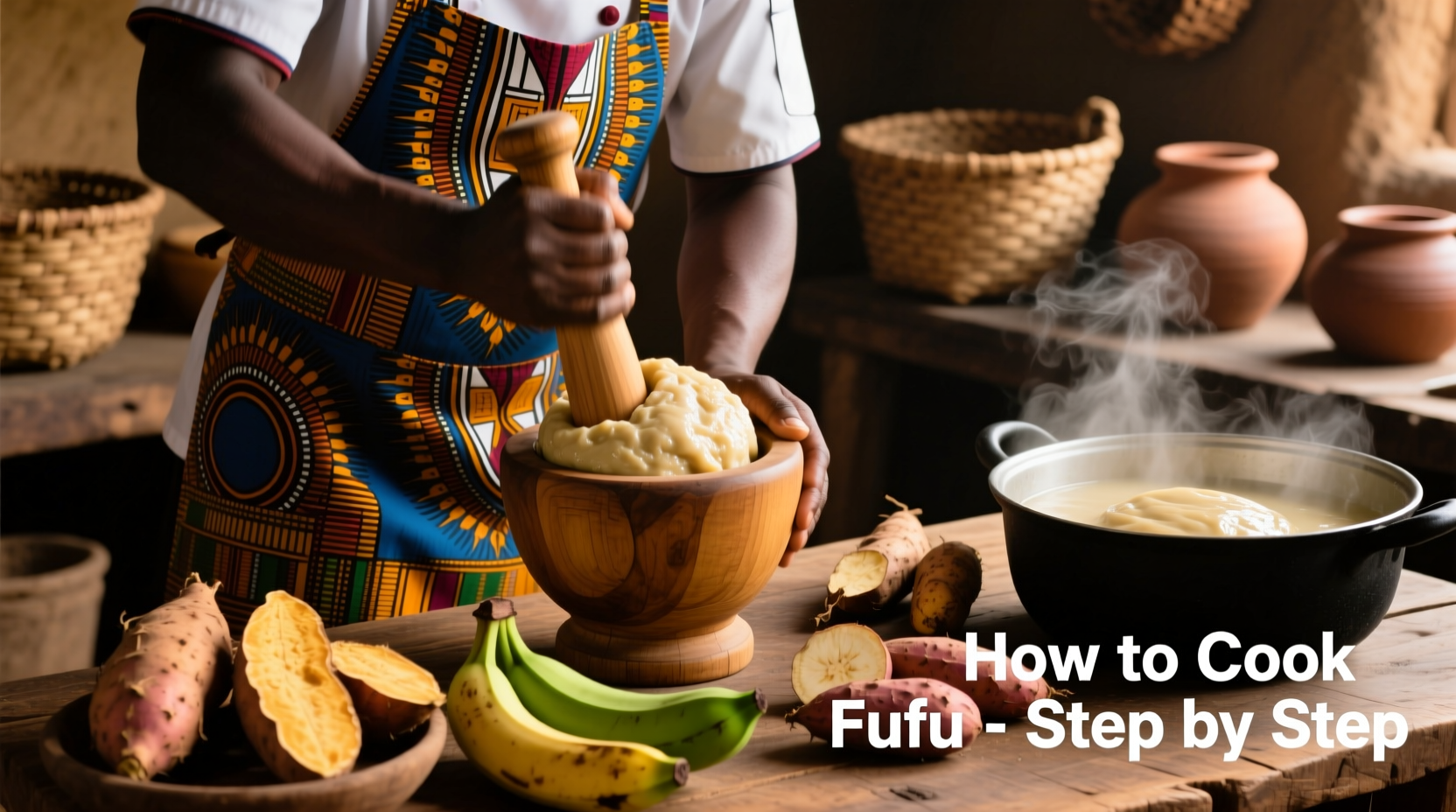Master the art of making authentic fufu with this comprehensive guide that reveals traditional techniques passed down through generations. Whether you're using fresh cassava or convenient instant fufu flour, you'll learn exactly how to achieve the perfect smooth, elastic texture that defines this beloved West African staple. Discover time-tested tips for avoiding common pitfalls like lumps, improper consistency, and flavor imbalances that can ruin your dish.
Understanding Fufu: More Than Just a Side Dish
Fufu serves as both cultural touchstone and culinary foundation across West Africa and the Caribbean. This versatile dough-like staple, traditionally made from fermented cassava, plantains, or yams, forms the perfect vehicle for scooping up flavorful soups and stews. The preparation method—boiling followed by vigorous pounding—creates a unique texture that's simultaneously smooth, stretchy, and slightly tangy from natural fermentation.
| Traditional Preparation | Modern Method |
|---|---|
| Requires 30-45 minutes of manual pounding | Instant fufu flour preparation in 5-7 minutes |
| Natural fermentation develops complex flavors | Less complex flavor profile |
| Requires specific tools (mortar and pestle) | Only needs pot and whisk |
| Authentic stretchy, elastic texture | Texture can be inconsistent |
Essential Ingredients for Perfect Fufu
The beauty of fufu lies in its simplicity—typically requiring just one or two main ingredients depending on the regional variation:
- Cassava fufu: Fresh cassava root (peeled, boiled, and pounded) or high-quality cassava fufu flour
- Plantain fufu: Unripe green plantains (boiled and pounded)
- Yam fufu: White yams (boiled and pounded)
- Water: For boiling and adjusting consistency
- Salt: A pinch to enhance flavor (optional)
For traditional cassava fufu, the fermentation process is crucial—it develops the characteristic slight tang and improves digestibility. According to research from the Food and Agriculture Organization of the United Nations, proper fermentation of cassava reduces cyanogenic compounds while developing beneficial enzymes.

Traditional Fufu Preparation: Step-by-Step
While time-consuming, the traditional method yields superior texture and flavor. This technique has been perfected over centuries across West Africa:
- Prepare the cassava: Peel fresh cassava roots, remove the fibrous core, and cut into chunks. Soak in water for 2-3 days to ferment (change water daily).
- Boil: Drain and boil the fermented cassava until completely tender (about 20-25 minutes).
- Drain thoroughly: Remove excess water to prevent a soupy consistency.
- Transfer to mortar: Place half the boiled cassava into a large wooden mortar.
- Pound vigorously: Using a pestle, pound in a circular motion while rotating the mortar. This requires significant physical effort.
- Add remaining cassava: Gradually add the rest while continuing to pound.
- Adjust consistency: Add small amounts of warm water as needed to achieve smooth, elastic dough.
- Test texture: Properly prepared fufu should stretch when pulled and hold its shape when rolled into balls.
Modern Method Using Fufu Flour
For those without access to fresh ingredients or traditional tools, instant fufu flour offers a practical alternative while maintaining authentic flavor:
- Boil water: Bring 2½ cups of water to a rolling boil in a medium pot.
- Add flour gradually: Slowly pour 1½ cups of fufu flour into the boiling water while stirring constantly with a wooden spoon.
- Stir continuously: Maintain vigorous stirring to prevent lumps as the mixture thickens.
- Cook for 5-7 minutes: Continue stirring until the mixture pulls away from the sides of the pot and forms a smooth ball.
- Knead: Transfer to a lightly floured surface and knead for 1-2 minutes until smooth and elastic.
- Rest: Cover with a damp cloth for 5 minutes before serving.
Troubleshooting Common Fufu Problems
Even experienced cooks encounter challenges with fufu preparation. Here's how to fix the most frequent issues:
- Lumpy texture: This occurs when flour isn't incorporated properly. Solution: Return to heat and stir vigorously for 2-3 more minutes, or use a whisk to break up lumps.
- Too sticky: Indicates excess moisture. Solution: Knead in small amounts of additional flour until desired consistency is reached.
- Too dry/crumbly: Result of insufficient water. Solution: Gradually add warm water (1 teaspoon at a time) while kneading.
- Lacks elasticity: Often happens with instant flour when not cooked long enough. Solution: Return to heat and cook for additional 2-3 minutes while stirring.
- Sour flavor too strong: Over-fermentation. Solution: Reduce fermentation time to 24-48 hours for milder flavor.
Serving and Storing Fufu Properly
Fufu is always served fresh and warm for optimal texture. Here's how to present and preserve it correctly:
Form fufu into smooth, round balls about the size of a tennis ball. Create a small indentation with your thumb to help scoop up soups. Traditional West African accompaniments include light soups like okra soup, groundnut soup, or palm nut soup. Never serve fufu cold—it loses its characteristic texture when chilled.
For short-term storage (up to 24 hours), keep fufu covered with plastic wrap pressed directly against the surface to prevent drying. Reheat by placing in a steamer for 5-7 minutes until warm throughout. According to food safety guidelines from the World Health Organization, cooked fufu should not be kept at room temperature for more than 2 hours to prevent bacterial growth.
Regional Variations Worth Exploring
While cassava fufu dominates in Ghana and Nigeria, regional variations showcase Africa's culinary diversity:
- Ghanaian fufu: Typically made from cassava and plantains, served with light soups
- Nigerian fufu: Often includes cocoyam for added smoothness
- Cameroonian fufu: Made from boiled and pounded cocoyam
- Caribbean funji: Cornmeal-based variation brought through the transatlantic slave trade
- Igbo pounded yam (iyan): Made exclusively from yams, considered a delicacy
Understanding these regional differences helps appreciate fufu's cultural significance beyond mere sustenance—it represents community, tradition, and culinary heritage.











 浙公网安备
33010002000092号
浙公网安备
33010002000092号 浙B2-20120091-4
浙B2-20120091-4